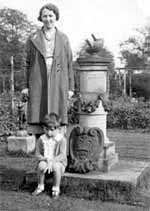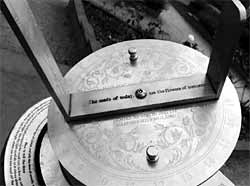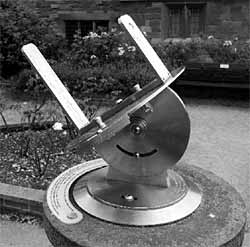Articles from the Thoroton Society Newsletter
The heliochronometers at Rufford Abbey : Remembering King Edward VII

The original heliochronometer, 1930s © Nottinghamshire County Council
A heliochronometer is an extremely precise form of sundial which applies corrections to the time according to the sun to give a very accurate reading of the mean time as shown by ordinary clocks and watches. A well-maintained heliochronometer will give the clock time with a precision of a few seconds. Before the days of radio time signals, in many parts of the world, the only way of setting clocks was by means of a heliochronometer. Over a thousand of the instruments were made and distributed all over the British Empire and to other parts of the world. Production of heliochronometers by the instrument makers Negretti and Zambra only ceased in around 1913. There is an example of a heliochronometer in the garden at Bromley House Library.
Rufford Abbey in North Nottinghamshire was originally a Cistercian religious house. Following the Dissolution of the Monasteries the building passed to George Talbot, Earl of Shrewsbury and his wife Bess of Hardwick and then to the Savile family. The second Baron Savile was a close friend of King Edward VII, and the King and Queen Alexandra were frequent visitors to Rufford. The King died in 1910 and Lord Savile was apparently heartbroken. In memory of his old friend, Lord Savile had a small pillar erected in the Rose Garden at Rufford, bearing the words “In memory of King Edward VII. Though the voice is hushed, his wondrous spell is in our hearts." Lord Savile also purchased a Gibbs-Pilkington heliochronometer, reportedly at a cost of ten guineas, and had it installed on the pillar.

The finely decorated baseplate of the new heliochronometer.

The new heliochronometer in situ in the new rose garden at Rufford Abbey.
When Rufford Abbey was sold in 1938, its contents were auctioned. One lot is described in the sales catalogue as ‘Rose Garden. Lot 2913. A bronze sundial on stone pedestal with escutcheon tablet and inscription’. The ‘bronze sundial’ was sold but the pillar was left behind.
Rufford Abbey is currently owned by the Nottinghamshire County Council. In 2009, the Council decided to restore the Rose Garden at Rufford. Unfortunately, the site of the original rose garden is uncertain, so a new rose garden was created. The original pillar with the memorial to King Edward VII was found and it was decided to install a modern heliochronometer on it. The job of making the instrument was given to Mr John Gunning of Petersfield, Hampshire. Amongst the requirements for the new instrument were that it should be made in stainless steel, not the more valuable (and stealable) bronze or brass and should be vandal-proof. This precluded the traditional mechanism which converted solar time to clock time and is, by its nature, vulnerable. Mr Gunning’s design uses a much simpler (but less precise) means of converting solar to mean time but is very elegant with a lovely flower design on the main plate. So, Rufford now has its memorial to King Edward VII restored. Please go and look at it next time you visit Rufford.
With thanks to Philip Jones and Linda Hardy for their help with this article.
John Wilson
Post-Script: I presented a paper on the Rufford heliochronometers at the British Sundial Society annual conference recently. During discussions, a member said that he believed that Queen Alexandra had an interest in sundials and had installed a heliochronometer at Windsor Castle. Could it have been the Queen’s interest that inspired Lord Savile to use a heliochronometer as part of his memorial to the late King? - a research topic for someone, perhaps?
< Previous